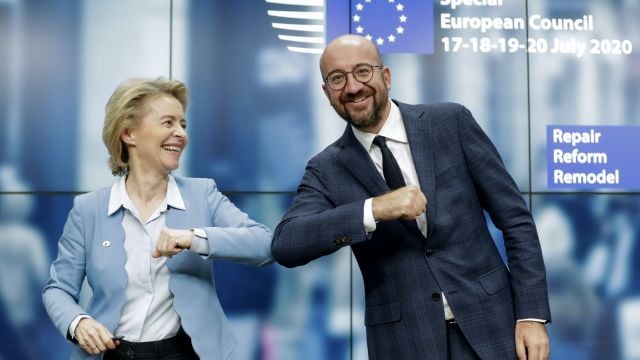Pushed by Germany’s Angela Merkel and France’s Emmanuel Macron, leaders agreed to borrow jointly by selling bonds, using the European Union’s collective strong credit rating that keeps interest costs low.
The money will fill a 750 billion euro (£676 billion) recovery fund to boost the hoped-for economic rebound next year and restore the growth and jobs lost in this year’s plunge.
Two decisions – shared borrowing, and simply handing out much of the money as grants – broke through longstanding opposition from some of the financially stronger countries to exposing their finances and taxpayers to troubles in southern Europe, where bureaucracy and red tape continue to slow growth.
Germany, which had long resisted shared borrowing, played a decisive role by changing its approach in the face of the crisis as Ms Merkel pressed for a deal.
The EU’s executive commission predicts the bloc’s economy will shrink by 8.7% this year and rebound by 6.1% next year. The goal of the spending is to support that upswing.
By turning to shared debt and spending, the EU is taking a different approach to solidarity than during the 2010/15 debt crisis that pushed Greece and four other members of the 19-country eurozone into international bailouts.
#EUCO conclusions on the #NextGenerationEU recovery package and the #EUbudget for 2021-2027
👉 https://t.co/0TRghmsIMH pic.twitter.com/hPeVfmw1Li— EU Council Press (@EUCouncilPress) July 21, 2020
Greece was rescued with loans that have to be repaid, increasing its debt load. That help came with tough conditions to rein in government spending that reduced growth, spread hardship and fuelled resentment.
The four-day summit put the bloc’s deep-seated fault lines on display. To overcome resistance from five European countries led by the Netherlands, they trimmed the amounts to be dispensed as grants and increased the amount offered as loans that have to be paid back.
The money will not kick in until next year and the fund is a one-off, meaning that while it sets an important precedent it does not necessarily lead to ongoing mutual support that could be counted on in any future crisis.
The grant provision is important because it will enable countries like Italy and Spain to spend more on their economies without adding to their national debt piles.
I believe this agreement will be seen as a pivotal moment in Europe's journey.
It will launch us into the future. The first time in our history the budget will be clearly linked to our climate objectives.#EUCO pic.twitter.com/FH4tScETpC— Charles Michel (@eucopresident) July 21, 2020
Both were hard hit by the virus outbreak and Italy in particular has a large debt burden that must be regularly rolled over with new borrowing. A huge spike in debt could deter bond markets from lending at affordable rates.
Resistance from the Netherlands, Austria, Sweden, Finland and Denmark reflected scepticism about the pace of economic reform in the countries that need help.
Although the European response is spread across EU institutions, the European Central Bank, and the individual nations’ governments, economists say the stimulus figure is weighty enough to impress international investors so they will keep lending to indebted countries such as Italy and avoid another debt crisis.
The 750 billion euro recovery fund comes on top of a 1.1 trillion euro (just under £1 trillion) EU budget that pays for the union’s agricultural support, projects to help poorer members catch up and myriad other programmes.
That follows up to 540 billion euros (£486 billion) in aid for wage support programmes to hold down unemployment, and credit lines that hard-hit countries could tap from the eurozone’s bailout fund.
Another 1.35 trillion euros (£1.2 trillion) is being printed by the European Central Bank and injected into the economy through a series of bond purchases that hold down market borrowing costs for businesses, governments and consumers.







